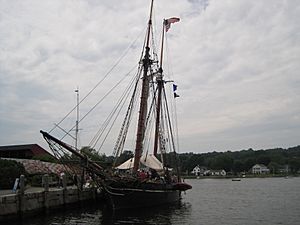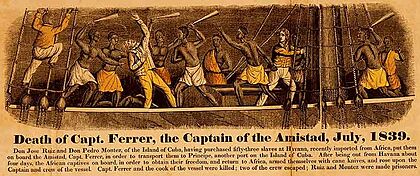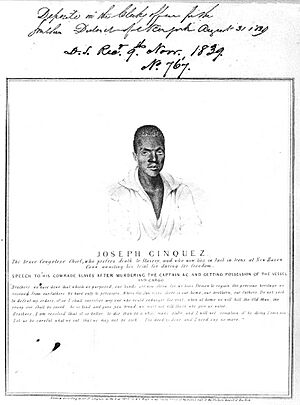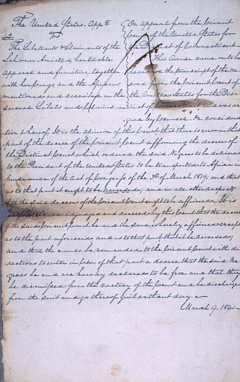La Amistad facts for kids

La Amistad off Culloden Point, Long Island, New York on August 26, 1839
(contemporary painting, artist unknown) |
|
| Name | La Amistad |
| Owner | Ramón Ferrer |
| Acquired | Pre-June 1839 |
| Name | Ion |
| Namesake | Ion (mythology) |
| Owner | Captain George Hawford, Newport, Rhode Island |
| Acquired | October 1840 |
| Acquired | 1844 |
| General characteristics | |
| Length | 120 ft (37 m) |
| Sail plan | Schooner |
La Amistad (which means The Friendship in Spanish) was a 19th-century sailing ship. It became famous in 1839 when a group of captured Africans on board fought for their freedom. These people, mostly from the Mende ethnic group, had been kidnapped from their homes in West Africa. They were illegally brought to Cuba to be sold as slaves.
In Cuba, two Spanish plantation owners bought 53 of the captives, including four children. They planned to transport them on La Amistad to a different part of the island. But a few days into the journey, a brave man named Sengbe Pieh (later called Joseph Cinqué) freed himself and the others. They took control of the ship, and in the struggle, the ship's captain and cook were killed.
Pieh demanded that the Spanish men sail the ship back to Africa. Instead, the men secretly sailed north along the coast of the United States. They hoped the ship would be found, and the Africans would be returned to Cuba as slaves. The ship was eventually stopped off the coast of Long Island, New York.
The Mende people were taken to a jail in New Haven, Connecticut. This led to a famous court case called United States v. The Amistad. The case went all the way to the Supreme Court of the United States. The court decided that the Africans were not slaves but free people who had been kidnapped. They had the right to fight for their freedom. This story became a powerful symbol for people who were working to end slavery in the United States.
Contents
About the Ship
La Amistad was a two-masted schooner, a type of sailing ship, about 120 feet (37 m) long. It was not built to be a slave ship that crossed the Atlantic Ocean. Instead, it was used for shorter trips, carrying sugar and other goods around Cuba and the Caribbean islands. It sometimes carried a small number of passengers or enslaved people from one port to another.
The 1839 Rebellion
On June 28, 1839, La Amistad left Havana, Cuba. On board were 53 African captives: 49 adults and four children. They had been captured in Africa and brought to Cuba on a different ship, which was illegal according to international treaties against the Atlantic slave trade.
The captives were not kept in special slave quarters. About half were in the main hold below deck, and the others were on the deck. This gave them a chance to plan their escape. Below deck, they found a rusty file and used it to break free from their chains.
Taking Control of the Ship
Around July 1, the freed men rushed up to the deck. They were armed with large knives used for cutting sugar cane. Led by Sengbe Pieh, they took control of the vessel. During the fight, the captain and the ship's cook were killed. Two of the African captives also died.
The Mende people spared the lives of the two Spanish men who had bought them, José Ruiz and Pedro Montes. They needed them to navigate the ship back to their home in Africa. However, Montes tricked them. At night, he would steer the ship north, up the coast of North America.
For weeks, La Amistad drifted. Other ships spotted it, but no one was able to help. Finally, a U.S. Navy ship, the USS Washington, found La Amistad and took it into custody.
The Famous Court Case
The arrival of La Amistad in the United States started a major legal battle. The case, known as United States v. The Amistad, became famous around the world. The main question was: what was the legal status of the Mende captives?
- The Spanish government argued that the Africans were slaves and property. They said the captives should be returned to Cuba to be punished for the rebellion.
- Abolitionists, people who wanted to end slavery, argued that the Mende were free people. They said the Africans had been illegally kidnapped and had the right to defend themselves.
A group called the Amistad Committee was formed to help raise money for the Africans' defense.
A lawyer named Roger Sherman Baldwin and former U.S. President John Quincy Adams argued their case.
In 1841, the Supreme Court of the United States made its final decision. The court ruled that the Mende people had been illegally kidnapped and transported. Therefore, they were legally free and had acted in self-defense. The court ordered them to be freed.
After the trial, 35 of the survivors were able to return to Africa in 1842. Their journey home was paid for by abolitionist groups.
What Happened to the Ship?
After the court case, La Amistad was sold at an auction in October 1840. A sea captain from Newport, Rhode Island, named George Hawford, bought the ship. He renamed it Ion.
Captain Hawford used the Ion as a trading ship. He sailed it to places like Bermuda and the Caribbean, carrying goods like onions and apples. In 1844, he sold the ship in Guadeloupe. After that, no one is sure what happened to the original La Amistad.
Legacy of La Amistad
The story of La Amistad is remembered as an important event in the fight against slavery.
- The Amistad Memorial is a statue in front of the City Hall in New Haven, Connecticut, where the trial took place.
- The Amistad Research Center at Tulane University in New Orleans studies the history of slavery and civil rights. It is named to honor the Mende people's fight for freedom.
A Modern Replica Ship

Freedom Schooner Amistad at Mystic Seaport in 2010
|
|
| Owner |
|
| Builder | Mystic Seaport |
| Laid down | 1998 |
| Launched | March 25, 2000 |
| General characteristics | |
| Tons burthen | 136 L. tons |
| Length | 80.7 ft (24.6 m) |
| Beam | 22.9 ft (7.0 m) |
| Draft | 10.1 ft (3.1 m) |
| Propulsion | Sail, 2 Caterpillar diesel engines |
| Sail plan | Topsail schooner |
From 1998 to 2000, a replica of La Amistad was built at Mystic Seaport in Connecticut. It is called the Freedom Schooner Amistad. Since there were no blueprints of the original ship, builders used old drawings and their knowledge of similar ships from that time.
The replica ship is not exactly the same as the original. It is slightly longer and has modern diesel engines for safety. Its mission is to travel to different ports and teach people about the history of slavery, civil rights, and the story of the Amistad. Its home port is New Haven, Connecticut, where it continues its educational mission.
See also
 In Spanish: La Amistad (barco) para niños
In Spanish: La Amistad (barco) para niños
- African Slave Trade Patrol
- Bibliography of early American naval history
- Blockade of Africa
- Creole case
- John Quincy Adams and abolitionism
- List of historical schooners
- List of ships captured in the 19th century
- Sarah Margru Kinson




